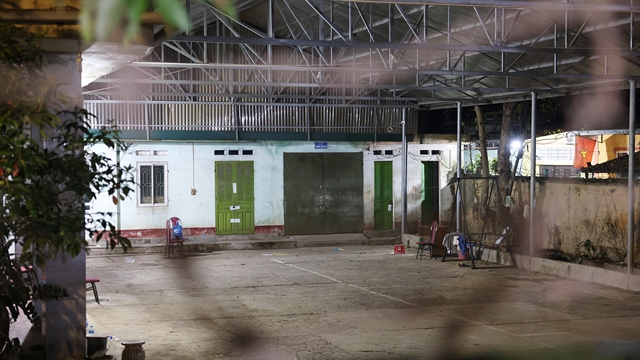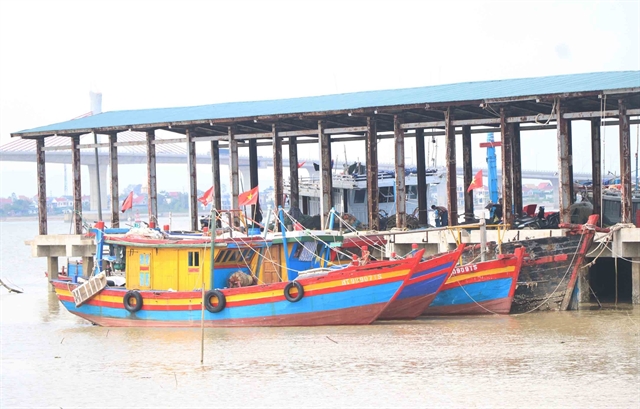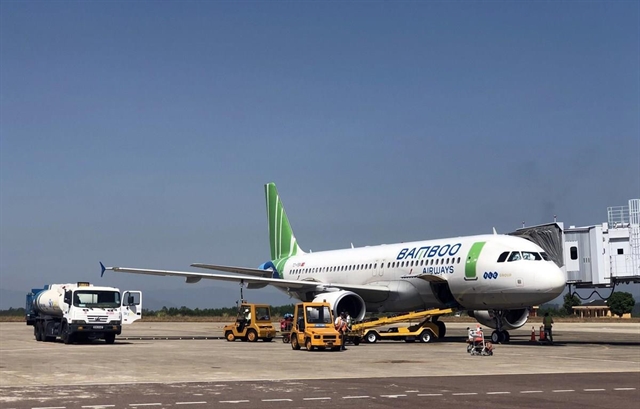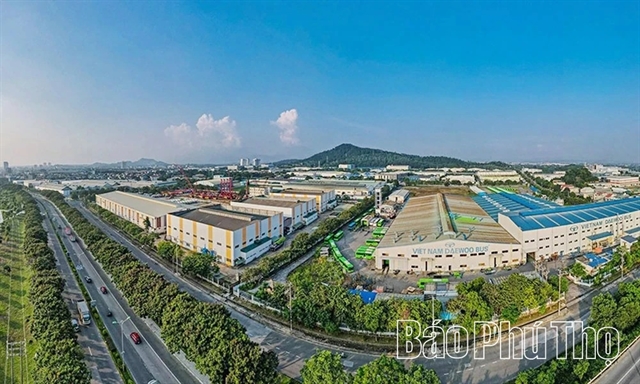 Society
Society


|
| Vessels anchor at Xuân Hội Fishing Port to avoid the super typhoon Ragasa in the coastal central province of Hà Tĩnh on Tuesday.— VNA/VNS Photo Công Tường |
HÀ NỘI — Coastal provinces and cities are racing against time to prepare for super Typhoon Ragasa, the ninth storm to hit the East Sea (internationally known as South China Sea) this year, with sustained winds forecast at up to 221 km/h and rainfall exceeding 400 millimetres. Authorities are calling on residents, farmers and businesses to act swiftly as the northern region braces for potentially devastating weather.
According to the National Centre for Hydro-Meteorological Forecasting, the typhoon is expected to make landfall over the coastal waters of Quảng Ninh and Hải Phòng by 1pm on Thursday with intensity of level 9-10, gusting to level 12.
The storm is projected to unleash destructive weather across the northern region, Thanh Hóa and Nghệ An provinces between Wednesday night and Friday.
During a meeting with local authorities of affected provinces and cities on Tuesday afternoon, Deputy Prime Minister Trần Hồng Hà urged localities to urgently harvest aquatic products that are ready for exploitation to minimise losses, while ensuring absolute safety for fishermen.
Emphasising that reservoir safety must be ensured, with top priority given to hydropower dams, the Deputy Prime Minister requested the Ministry of Agriculture and Environment to work closely with the Ministry of Industry and Trade, which manages most hydropower reservoirs, as well as meteorological forecasting units, to operate and control water levels, provide accurate forecasts and implement timely solutions.
Although the typhoon has been downgraded, it is forecast to carry the risks of whirlwinds, heavy rain and hazards. Meteorological agencies must strengthen forecasting with visuals and easy-to-understand warning information so that people can clearly grasp the situation and take proactive preventive measures, he said.
Noting that a tropical depression or another storm may form after Typhoon Ragasa, the Deputy Prime Minister urged ministries, sectors and localities to immediately prepare subsequent response plans.
On Tuesday, the northern city of Hải Phòng convened an urgent meeting to coordinate storm preparations. Vice Chairman of the municipal People’s Committee, Trần Văn Quân, said Ragasa is a 'super typhoon of extreme intensity, moving at high speed and posing unpredictable risks.' He urged the city’s political system to operate at maximum vigilance, prioritising the protection of human life and property.
Authorities were ordered to review existing disaster-response plans, particularly the relocation of residents from vulnerable coastal zones, low-lying areas and dilapidated housing blocks. Evacuations must be carried out 'carefully and safely,' with provisions for temporary accommodation ensuring basic living conditions, Quân said.
Maritime authorities have tightened monitoring of fishing vessels, floating cages and tourist activities, demanding a complete withdrawal from danger zones. Key sectors of electricity, telecommunications, transport and health have been tasked with maintaining uninterrupted services, readying emergency supplies and ensuring round-the-clock coordination.
By 9am on Tuesday, the city’s Department of Agriculture and Environment reported that 1,604 fishing vessels with 4,481 crew members, 271 fish cages with 233 workers, and three offshore watch huts had been accounted for, with most having returned to safe harbours and no cases of lost contact.
Meanwhile, nearly 800 kilometres of dykes are under review, including 75 critical points. Flood drainage companies have placed pumps and equipment on standby while urging farmers to accelerate the harvest of rice, vegetables and aquaculture products.
The city’s Department of Construction has prepared plans to relocate almost 3,000 households from 79 severely degraded apartment blocks, with temporary shelter to be provided in schools and community halls. Coastal communes are also planning the evacuation of nearly 500 households, while tourist facilities in Cát Hải and Đồ Sơn have been instructed to safeguard visitors.
In the central coastal province of Hà Tĩnh, Deputy Chairman of the provincial People’s Committee Nguyễn Hồng Lĩnh issued Directive 41/CD-UBND, suspending all non-essential meetings from Wednesday to free up resources for storm response. Local leaders were told they would be held directly accountable for any loss of life due to negligence.
Border guards, the military, port authorities and coastal districts have moved quickly to verify all vessels at sea. Fishermen are being kept updated on the typhoon’s track and guided to safe shelters, with authorities warning that a ban on going to sea will be imposed if necessary.
Rescue forces are on high alert for worst-case scenarios. Plans are also in place to help residents reinforce homes, harvest crops, and protect livestock and aquaculture facilities.
Public infrastructure, particularly dykes, reservoirs, warehouses and power lines, is being strengthened and tourist beaches and resorts will be strictly closed when the storm makes landfall.
.jpg)
|
| A worker of Hải Phòng Green Tree Joint Stock Company trims trees to cope with the typhoon Ragasa on Tuesday in the northern city of Hải Phòng.—VNA/VNS Photo Hoàng Ngọc |
Dykes, national power grid protection
In a related move, the Ministry of Agriculture and Environment has instructed northern and north-central provinces to step up protection of critical dyke systems.
Local governments are required to patrol sea and river dykes in line with regulations, detect and repair weaknesses promptly, and prepare personnel and equipment for emergencies.
Particular attention is being given to vulnerable coastal dykes in Quảng Ninh, Hải Phòng, Hưng Yên, Ninh Bình, Thanh Hóa, Nghệ An and Hà Tĩnh. Authorities must ensure that unfinished construction sites and previously damaged sections are secured ahead of the storm.
Meanwhile, the Ministry of Health has directed hospitals and clinics across the north and central regions to prepare for medical emergencies.
Facilities must maintain round-the-clock emergency cover, stockpile essential medicines and safeguard patients and staff in flood-prone areas.
In addition, environmental sanitation, clean water supplies and food safety measures are to be strengthened both during and after the storm.
The Ministry of Science and Technology has ordered telecoms companies to activate contingency plans to maintain communications, including network roaming within 30 minutes of service disruptions.
Mining sites, hydropower reservoirs and downstream communities will receive intensified monitoring and information.
Maritime broadcasting services are working with the National Centre for Hydro-Meteorological Forecasting to issue storm alerts and instruct vessels to leave danger zones.
The National Load Dispatch Centre (NSMO) has prepared multiple scenarios to safeguard the national power system. Deputy General Director Vũ Xuân Khu said flexible operation plans have been activated to minimise disruption and ensure rapid recovery after the storm.
Measures include reducing transmission loads in high-risk regions, coordinating with hydropower plants to balance safety with downstream flood control, and maintaining constant communication between control centres, transmission companies and power plants.
Special attention will be given to restoring electricity for essential services in disaster response once the storm passes.
Meteorological warnings
According to the National Centre for Hydro-Meteorological Forecasting, by 1pm on Tuesday super typhoon Ragasa had maximum sustained winds of 184–221 km/h, with gusts exceeding that level, and is moving west-northwest at about 20 km/h.
From Wednesday, gales of up to force 14 are expected in the northern part of the East Sea, with waves rising above 10 metres. By Wednesday evening, the Gulf of Tonkin will face storm-force winds of up to force 12 and waves of four to six metres.
Onshore, winds will strengthen in Quảng Ninh to Thanh Hóa provinces from Thursday morning, reaching force 10 in some areas, with the wider northeast also experiencing strong gusts. Rainfall of 100–250 millimetres is forecast across the northern region, Thanh Hóa and Nghệ An provinces, with some localities exceeding 400 millimetres. Authorities warn of widespread flooding, flash floods and landslides.
Meteorologists also caution of severe thunderstorms, tornadoes and violent squalls both before and during the typhoon’s landfall. — VNS




